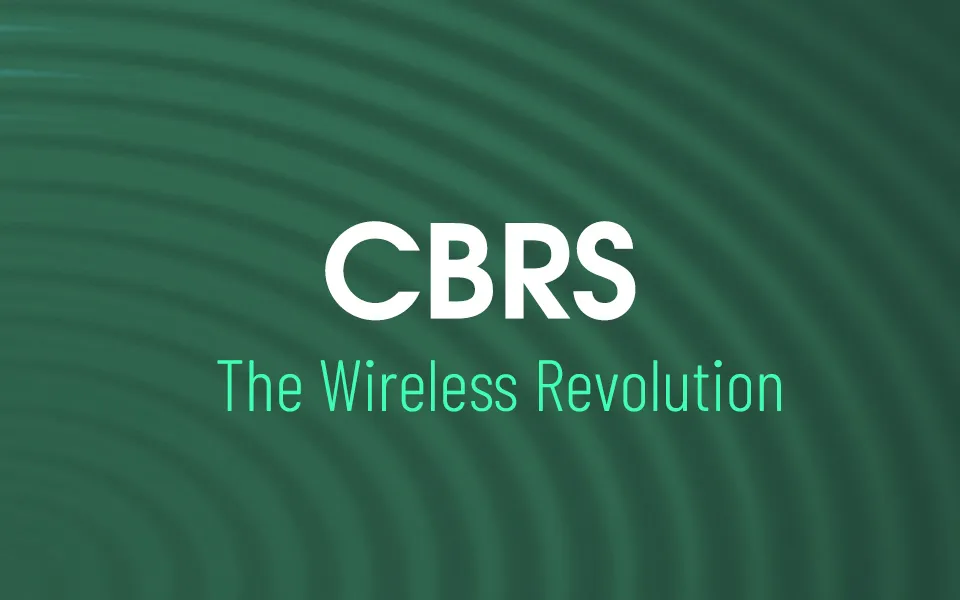CBRS: The Wireless Revolution
The Citizens Broadband Radio Service (CBRS) stands at the forefront of spectrum innovation, offering a groundbreaking approach to shared wireless broadband use. This spectrum strategy not only maximizes efficiency but also paves the way for a myriad of cutting-edge applications and services.

The CBRS Advantage: Elevating Wireless Connectivity
Superior Coverage: CBRS is transforming the landscape of wireless connectivity with its ability to offer extensive network reach. Unlike traditional Wi-Fi, which can be limited by range and obstacles, CBRS operates on a spectrum that allows for broader and more consistent coverage. This means fewer dead zones and a reliable connection even in densely built environments or across sprawling campuses. With CBRS, users can experience seamless connectivity that extends far beyond the limitations of conventional networks.
Fortified Security: Security is paramount in today’s digital age, and CBRS addresses this concern head-on. By utilizing advanced encryption and SIM-based authentication, CBRS offers a level of security that is a significant upgrade over the typical Wi-Fi network. This robust security framework ensures that sensitive data remains protected, providing peace of mind for businesses and individuals alike.
Economic Efficiency: One of the most compelling benefits of CBRS is its cost-effectiveness. Organizations can deploy private LTE networks using CBRS without the hefty price tag associated with purchasing spectrum licenses. This opens up opportunities for a wide range of businesses to create their own secure, private networks without a substantial upfront investment, leading to long-term savings and operational efficiencies.
Spectrum Flexibility: The dynamic spectrum allocation of CBRS is a testament to its flexibility. It allows for a more efficient use of the spectrum, accommodating a diverse array of use cases from industrial IoT applications to commercial broadband services. This adaptability makes CBRS an ideal choice for organizations looking to future-proof their wireless infrastructure and stay ahead in a rapidly evolving technological landscape.
Band 48 CBRS: The Heartbeat of 5G CBRS
Band 48 is not just a part of the CBRS; it is the very essence that makes CBRS a viable solution for next-generation wireless networks. It operates within the 3.5 GHz range, which is ideal for both 4G LTE and 5G NR technologies. This band is particularly crucial for private network deployments because it offers the full suite of 5G benefits:
High-Speed Data: Band 48 enables data transfer at speeds that rival traditional broadband connections, making it suitable for a myriad of applications, from high-definition video streaming to real-time data analytics.
Minimal Latency: The low latency characteristic of Band 48 is essential for applications requiring real-time responsiveness, such as autonomous vehicles, remote surgery, and interactive gaming.
Expansive Network Capacity: With its ability to handle a large number of simultaneous connections, Band 48 is perfect for densely populated areas and IoT ecosystems, where thousands of devices need to connect without congestion.
CBRS and 5G: A Comparative Analysis
While CBRS shines in the mid-band spectrum, 5G encompasses a much wider array of frequencies, ranging from low-band to millimeter-wave (mmWave) bands. Here’s how CBRS stands out in comparison to traditional 5G:
Shared Spectrum Model: CBRS uses a novel three-tiered spectrum sharing model that allows for efficient use of the 3.5 GHz band. This model is distinct from the typical licensed spectrum approach used in conventional 5G deployments.
Accessibility: The shared model of CBRS democratizes access to the spectrum, enabling a broader range of entities, including businesses and local governments, to establish their own private networks without the need for costly spectrum auctions.
Flexibility and Innovation: The CBRS framework fosters innovation by providing a testbed for new wireless technologies and services, which can be developed and deployed more rapidly than in the licensed spectrum.
Band 48 CBRS: The Vanguard of Private Networks
Band 48 is at the forefront of the private network revolution, offering significant advantages over traditional Wi-Fi and public cellular networks:
Dedicated Connectivity: Private networks built on Band 48 offer dedicated connectivity, which is not subject to the same interference and congestion issues as public networks.
Data Security and Privacy: By keeping data local and utilizing dedicated radio equipment, Band 48 ensures enhanced security and privacy for network users, which is paramount for sensitive applications.
Customized Network Services: Band 48 allows for the customization of network services to meet specific industry needs, including quality of service (QoS), bandwidth allocation, and latency requirements.
In Conclusion: The Architect of Tomorrow’s Connectivity
The Citizens Broadband Radio Service (CBRS), and Band 48 in particular, are redefining the wireless communication paradigm. As we advance into the 5G era, the unique blend of flexibility, security, and cost-efficiency that CBRS offers positions it as the ideal solution for a wide array of applications. From robust corporate networks to the intricate web of the Internet of Things (IoT), CBRS is proving to be a versatile and powerful tool.
The spectrum sharing model introduced by CBRS is a significant innovation, allowing for more efficient and democratic use of the available frequencies. This model ensures that the spectrum is utilized to its fullest potential, paving the way for new technologies and services that can thrive without the constraints of traditional spectrum licensing.
Looking ahead, the principles and practices established by CBRS, especially with Band 48, are likely to influence global standards and become a cornerstone of future network deployments. The architecture of tomorrow’s connectivity, supported by CBRS, promises to bring about a more connected, efficient, and secure world.








